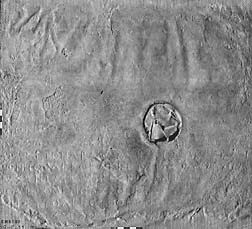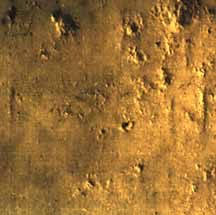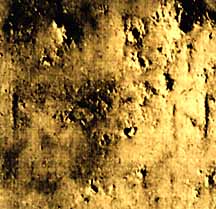
View 72 dpi image of IG, I3, 11
The dating of this inscription has been much debated in recent years. The surface of the stone has been severely eroded by its later reuse as a threshold block, but the stoichedon pattern of the lettering makes it possible to locate where letters that have been damaged must once have stood. The final two letters of the name of the eponymous archon (ON) have been read in line 3; letter traces in the immediately preceding two letter spaces have been interpreted to support the identification either of [Ha]bron (dated 458/7 BC) or of [Ant]iphon (dated 418/7 BC) as the archon in question. The dating of this inscription has a particular importance because the inscription uses letter forms (rho with a tail, as in upper case R, and sigma formed with 3 bars) that have widely been assumed to be diagnostic for dating other Athenian inscriptions before the mid-440s. If Antiphon is the correct reading in line 3, then palaeographical arguments for dating a number of other important documents relating to the history of the Delian League to the 440s or earlier dissolve and their interpretation will have to rest, instead, on historical and other considerations.
The inscription was subjected to detailed analysis, using image enhancement and laser scanning techniques, by a team led by Prof. Mortimer Chambers in the late 1980s. The results of this analysis, which strongly favoured the reading of [Ant]iphon, were published in an article in Zeitschrift für Papyrologie und Epigraphik in 1990 (M.H. Chambers, R. Gallucci, P. Spanos, "Athens' Alliance with Egesta", ZPE 83, 1990, 38-63), but have not been universally accepted: see, e.g., A.S. Henry, ZPE 91, 1992, 137-146, with Chambers' reply in ZPE 98, 1993, 71-74; and a further response from Henry, CQ n.s. 45, 1995, 237-40; cf. now also S.E. Dawson, ZPE 112, 1996, 248-252; and, most recently, M. Vickers, JHS 116, 1996, 171-4.
As a contribution to this continuing debate, Professor Chambers has given permission for his colour images of the inscription to be reproduced here alongside scanned images of a squeeze made in the 1930s and now in the squeeze collection in Oxford.
 |
 |
Colour image of letter spaces 35-38 of line 3 of IG, I3, 11 - unenhanced |
Computer-enhanced colour image of letter spaces 35-38 of line 3 of IG, I3, 11 |
Three views of the squeeze are available: the 72 dpi scan of the whole document signalled above; a 150 dpi scan of the upper right quarter of the squeeze with guide-lines imposed to mark the stoichedon pattern (also available at a resolution of 300 dpi); and a detailed 300 dpi scan of the disputed area. Some caution is required in using the grid lines imposed on the squeeze, since paper squeezes have a natural tendency to distort. The grid has, however, been traced as far as possible to correspond to letters clearly visible on the squeeze and should, therefore, not be too misleading.
W.K. Pritchett expressed doubts 40 years ago (AJA 59, 1955, 58-59) that anything at all could safely be read before ON, but this view seems too pessimistic. Letter traces on the squeeze are faint, but are, nevertheless, significant. The possible traces of a letter visible in space 36 correspond closely to those in the colour photographs. A comparison with the form of rho four letter spaces later and in the next space on the line above positively excludes rho. It is hard to see anything other than phi in this letter space. The preceding letter space is more problematic. The vertical mark, which seems to belong to a letter stroke, is, on any account, on the left side of the letter space, rather than exactly centered. The detailed measurements taken by Prof. Chambers and his team, however, indicate that its position in relation to the letter in the following space is what might be expected for iota. The corresponding letter space in line 2 contains an epsilon which is aligned a little further to the left than the vertical in line 3. A good comparison can also be made with epsilon and iota in letter spaces 35 and 36 of line 16 on the lower edge of the stone. Iota here is also aligned very much on the left side of its space.
To sum up: the evidence of stone and squeeze seem to favour the reading of [Ant]iphon as the eponymous archon in line 3, and a date for the inscription, accordingly, of 418/7 BC. The consequences of this dating for reconstructions of Athenian imperial history in the fifth century remain fully to be evaluated.
Category: Alliance
Subject: Athenian treaty with Egesta, dated by archon year
Date: 418/7(?) BC
Provenience: Athens
Location: Athens, Epigraphical Museum (Inventory EM 6568)
CSAD Home Page | Lists of Images | Search
The experimental images posted on these web pages are
intended for research and educational use only. Comments from users are invited and should be addressed to
csad@classics.ox.ac.uk
| Updated on |